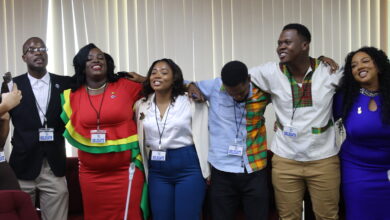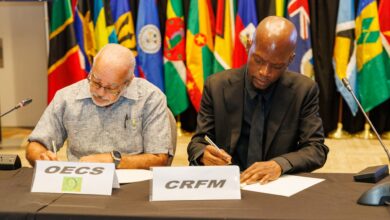It gives me great pleasure to participate in today’s celebrations marking the 75th Anniversary of this Institution and to deliver the feature address. My task has been made much more pleasant than anticipated by the scenic location of this noble Institution in the lush, green Maracas Valley with its high, majestic mountains on either side. The environment is indeed most relaxing and conducive to learning and the founders of the College deserve the highest praise for selecting this tranquil and beautiful location with its vast potential for development. The highest praise is also due to the successive administrations of the College who exploited the potential with great creativity and imagination, as demonstrated by the beautiful buildings around us.
My task this afternoon, even though in such a pleasant ambience, is somewhat difficult. This is so because the Institution has so many proud achievements to celebrate that doing justice to the theme “Celebrating Our Past ….. Challenging Our Future” in the time allocated poses a serious challenge for me. Time would allow me to highlight and speak only on a selected few of them. I therefore ask your forgiveness if I omit any which you think should have been included.
Enabling Environment and Early Development
There is no doubt that this Institution has not only survived but has thrived and developed in its 75 years of existence. The dynamism by this Institution is clearly evidenced by its history. From its humble beginnings in 1927 as the East Caribbean Training School, for the purpose of training youth for the Caribbean Union Conference, it grew by 1945 into the Caribbean Training College, to assist in meeting the regional need for trained primary school teachers. Two years later it was officially declared a junior college, and expanded its programmes to include two-year courses in Theology to provide better and more spiritual training for the youth of the Caribbean Conference, as well as courses in Business and Secretarial Sciences to meet the growing needs of the developing business sector in the Region.
The change of its name in 1956, from Caribbean Training College to Caribbean Union College enhanced its capacity to respond to the demands that were to be made on it in the 1970s and 80s to raise existing programmes to the degree level and to introduce new ones to meet changing needs. This development facilitated the extension of the two-year junior college course in Theology to a four-year Bachelor of Theology in 1970, and the conferring of Bachelor of Arts, Bachelor of Science, Bachelor of Business Administration and Associated Degrees in a wide range of major fields of study in affiliation with Andrews University, Michigan, USA starting 1985.
Over the years, the Caribbean Union College has surely developed into one of the leading tertiary institutions in the Region and is now one of seven Seventh Day Adventist (SDA) Institutions of higher learning in the vast Inter American Division which spans from northern Mexico to the Southern Amazon region of Colombia. I note with pleasure the outstanding support provided by the Institution for the improvement of primary and secondary education nationally/regionally through its association with primary and secondary schools operated by Adventists in the region.
The success of the College over the years has, however, not come easily. It has been a long and arduous process. Notwithstanding the many challenges, thanks to its founders, successive administrations, staff, students and supporters, it has developed and grown over the years.
Self-Reliance
We can’t but be impressed with this beautiful infrastructure which comprises the physical dimension of the College. Perhaps many of you may be saying to yourself that the Trinidad and Tobago tax-payer must have paid handsomely for it. Let me hasten to point out that that would be furthest from the truth. The Institution, has met the challenge of funding its physical development, particularly up to the late sixties, by relying on the sweat, toil, hard labour and self- sacrifice of its founders, staff and students and contributions from its supporters. It is a shining example of self reliance by a people, one which the nation and the region at large can adopt to their benefit.
The following excerpt from the letter of acceptance to the first batch of students in 1927 is instructive: “Don’t fail to bring with you a sharp cutlass …. bring sufficient bedding with you. The nights are a little cold here. We will furnish you with a cot only.” These lines embody the main pillars which comprise the very foundation of the Institution – self-reliance, self-sacrifice, commitment to hard work, dignity in manual labour.”
Ladies and gentlemen the construction of these sprawling buildings at which we are looking today spanned several years and according to the records of the College “not one dollar for hired labour was expended before 1970.”
I am sure that no one will deny the fact that this Institution deserves the highest praise for using the concept of self-reliance to deal with the challenge of funding its physical development. It is an example and a model so rarely followed in our society.
Equally instructive and laudable is the strategy used by the College, particularly in its early days, to meet the challenge of mobilising funds for recurrent expenditure. It used its creativity to raise the necessary funds by linking the curriculum to the production of goods and services needed by the national community and the wider Caribbean region. Manifestation of this policy was the establishment of many industries in the thirties and forties, industries such as, woodwork, poultry, printing, and later broom shop, wheat mill, green house, apiary and dairy.
This Institution has really been showing us the way forward since the thirties, but what have we learnt over the years? We are still talking today about curriculum relevance and the linking of the curriculum to production and to the world of work. This College has successfully demonstrated how this can be achieved a long time ago.
Self Reliance with Equity
We need to note also that linking the curriculum to the production of goods and services, brought with it a measure of equity by enabling poor and deprived students to gain access to further education and training since they were provided with the opportunity to work and to pay their way through college. The College, through this strategy, facilitated a considerably large number of such students to acquire advanced education and training. Providing such opportunity to the poor and deprived must be highlighted as one of the greatest achievements in the history of the College.
Resource Mobilisation – Role of the Alumni and Stakeholders
In keeping with its tradition, the College continues today to steadfastly avoid dependence on the public purse for its recurrent expenditure, relying instead on its various stakeholders, including the efforts of its past students. Its main sources of funding now include denominational appropriations, tuition fees, gifts and contributions from alumni associations, and to a very small extent, fees from the Government for a number of secondary school students.
The concepts on which the College has developed over the years – self-reliance, commitment to hard work, dignity in manual labour, giving something back to one’s Alma Mater are today no less relevant as critical elements of the philosophy needed for the development of this nation and indeed of this region.
Adapting to Change – Responding to Challenges
Given its history, we can’t but conclude, ladies and gentlemen, that this Institution owes its growth, development and sustainability to the principles which constituted its foundation and to its capacity to adapt to change and to respond to the various challenges which confront it. We need to take particular note of the fact that during its 75 years of growth, development and programme diversification, the Institution never sacrificed its focus on a strong religious and moral education which continues to this day be the platform for all its programmes. As a result, it has produced graduates not only with the required academic and professional qualifications but also with those values which are so necessary in present day society. This type of education provides the foundation which the youth of the Region need to inculcate and also sets a standard for other institutions of learning in the Region to emulate.
Beyond Parochialism and Regionalism
As an Institution with a student population largely from the Region, with the English-Speaking Caribbean accounting for the majority, the College has made a significant contribution to regional identity and harmonisation. A critical dimension of the College is that it has not been merely a parochial or even a regional Institution. It has had the distinction of being among the first regional further education and training institutions in the English-Speaking Caribbean. Starting in 1927 with a small number of students from the southern Caribbean, it now boasts an enrolment of approximately 350 comprising students from almost every English-Speaking Caribbean territory as well as students from the Dominican Republic, French Guiana, Guadeloupe, Martinique, Suriname and the Northern Antilles. Indeed its enrolment now extends beyond the Caribbean and includes students from Ghana, Indonesia, Kenya, Nigeria, USA and Venezuela.
The College therefore, is not only helping to promote regional identity, but also international understanding through the interaction between the students from the region and those from beyond.
Its Products
The Caribbean Union College has undoubtedly served the Region well. It has contributed significantly to the overall development of thousands and has demonstrated its ability to be a spiritual, social and educational light to the Caribbean. The leadership of the Adventist Church in the Caribbean since the mid-60s has been effectively carried on by its graduates. Thousands have joined the church because of the Christian service and dedication taught to CUC students. CUC has also contributed to the vision of thousands of students who have passed through its doors; but it is not simply by the number but by its fruits that it must be judged.
Many of its graduates have entered Government service or private industry in the Caribbean. A large number have migrated to the major metropolitan centres in Britain, Canada and the United States and have excelled in numerous professions including medicine, business, finance, law, science, music, religion and education. Many have held positions of great responsibility in various fields.
Among its illustrious graduates are Pastor G R Thompson, former College Board Chairman who served as Vice President of the General Conference of SDA following his election at the fifty-second General Conference Session held in Vienna Austria, 1975, and Dr Cuthbert B Arthur, a Thoracic Cardio-Vascular surgeon, a member of one of the most highly trained and skilled medical specialities. Dr Arthur, served as consultant to eight major medical centres in Californian including Loma Linda University Hospital and White Memorial Hospital both operated by the Adventist Church. Trinidad and Tobago as well as the wider Caribbean also benefited from his expertise. During 1963 and 1975-76 he served at the Port-of-Spain Adventist Hospital and, in April, 1976, performed the first successful implementation of a “pace maker” in a patient in the South Caribbean.
Another distinguished graduate is Dr Timothy Greaves, a well known Los Angeles pathologist whose courage and effervescence in the face of apparent insuperable difficulties after an automobile accident, brought hope and strength to all those who were privileged to know him. These few are among the many who have brought fame and glory to the Institution.
I am sure you will agree, CUC has had a glorious past which justifies today’s celebrations. It has been severely tested throughout its existence, but on every occasion has passed the test with distinction. It will again be rigorously tested during the Twenty-First century by current and emerging challenges which as a society, we face.
Meeting the Challenges Ahead
Prime among the major challenges are the demands on our region of the globalised knowledge-based economy, characterised by a heavy dependence on science and technology and economic competitiveness. To meet the challenges posed by those demands, the College will need to place even greater emphasis than it has so far done on producing highly skilled graduates to enable the Community to deal adequately with the digital age and globalisation, including most importantly for our region, economic competitiveness. This is one of the main goals which we hope would be advanced through the establishment of the Caribbean Single Market and Economy.
Another major challenge confronting the region is youth marginalisation and unemployment which latter is most pronounced amongst this age-group. Though the College is obviously playing its part in tackling these problems, this is an area which requires serious and urgent intensification of effort by all – public and private sectors, as well as philanthropic organisations. Without such widespread efforts, the critical role which human resource development must play in our economies and societies would remain unfulfilled, as would our society’s hopes for social and economic development.
Associated with this challenge are the scourges of drug addiction, and the spread of communicable diseases, particularly HIV/AIDS which threaten to destroy our most precious resource – our youth population. We do recognise the College’s outstanding contribution in the area of combating drug addiction, and in this regard the name Pastor Dottin is well known; but neither he nor the Caribbean Union College can do it alone – and there is still so much more to be done by all.
The HIV/AIDS epidemic poses a particularly, critical challenge for our region, which has the unenviable record of being second to sub-Sahara Africa, as regards the incidence of HIV/AIDS. The statistics are frightening. In this region one out of every 10 persons between 14-29 years is likely, given present trends, to contract this disease unless we work relentlessly, and successfully at public education and behaviourial change. This scourge currently afflicting some 40 million of mankind, having already killed over 20 million is playing havoc with the lives of our young people in particular and our population in general. It may not be readily appreciated, for example, that on that fatal September 11, when so many died in the USA at the hands of terrorists, many more died around the globe from AIDS on that day. We must never forget the maxim adopted by our Heads of Government at their 22nd Meeting in The Bahamas in July 2001, that the Health of the Region is the Wealth of the Region.
There is an equally urgent need to meet the challenge posed by religious fanaticism and the promotion of terrorism to which it gives rise. The urgent need to stem this tide of religious fanaticism by among other things, promoting greater understanding and tolerance of different religions and cultures is one of today’s pressing concerns. It would be the irony of ironies if in pursuit of their different religious doctrine for worshiping the Almighty, mankind was to destroy itself.
We must also not forget the serious challenge posed by the abuse of Women and the denial of their basic human rights in many countries. It is now generally recognised that these issues are matters of major concern to all – male and female. The Caribbean Union College, as a faith-based Institution, is certainly ideally positioned to give a lead in addressing these problems.
A specific challenge directed to the Tertiary institutions in the region is the need to develop the capacity for research and development in order to facilitate informed policy decision-making, implementation and progress in the Caribbean Community. Your College has already started to develop this capacity as indicated by the establishment of the Institute for Professional Development. Its research effort is being led by the researcher Mr Floyd Hayes, and it is hoped that this capacity will grow sufficiently to enable the Institution to contribute in this critical area. A similarly vital contribution is to be expected from the Trinidad and Tobago Institute of Technology and the University of Technology in Jamaica.
These, Ladies and gentlemen are just some of the challenges confronting the College, and indeed, the wider Caribbean Community in the Twenty-First Century. CUC, being a proactive Institution, has already developed a framework which provides the required strategic direction for the coming years. It has done so through a strategic plan with the following as it mission statement “Caribbean Union College provides tertiary level education in a number of professions to prepare its students for dedicated leadership and service to the wider Caribbean society and to the Seventh-day Adventist Church “ . This is a clear, unmistakable and dedicated commitment. The wider Caribbean society, part of which, namely CARICOM, now seeks to advance towards forging its many fragments of our regional society into a united Caribbean Community, including a Single Market and Economy (SME), which would need the values and principles that built this College over the last 75 years.
Scholarship Anchored in Values: Faith-based, Spirituality and Morality
As the College seeks to fulfil its mission, it would need in the foreseeable future to ensure that it lives by the following seven principles:
(i) the continued Promoting and facilitating of academic excellence;
(ii) Developing the student as a complete person – not only mentally, physically, socially, emotionally and vocationally, but critically spiritually;
(iii) Providing students with the opportunity to think clearly and communicate effectively;
(iv) Helping students develop competencies in craft, technical, and technological skills, especially including Information Technology;
(v) Providing varied opportunities for students to function as leaders;
(vi) Challenging students to respect and value ethnic and cultural diversity; something I am sure you will agree is sorely needed to stem the tide of ethnic fragmentation in the region and religious fanaticism elsewhere.
(vii) Creating an environment where the values and understanding of Christianity are promoted from a Seventh-day Adventist perspective.
A significant number of these principles is embodied in the vision of the ideal Caribbean person as envisioned by the CARICOM Heads of Government at their Eighteenth Meeting in Montego Bay, Jamaica in 1997.
The College has also articulated a focused vision to complement the mission statement and related commitments. That vision seeks to “transform Caribbean Union College into a flexible, caring, responsive, innovative, empowered, academically-informed, resourceful and technologically advanced seventh-day Adventist tertiary level Institution where students receive spiritual, cultural, emotional, professional, educational and social support and nurture in a Christian-centred environment.”
It is a vision with which I can find no fault, except its excessive modesty by using the word transform. By my reckoning the College is already living that vision, and needs perhaps only to intensify and transplant it to the wider society.
The mission statement and focused vision provide the required strategic framework within which the challenges identified can be addressed. Given its track record of responding to challenges, we have no doubt that the Caribbean Union College will effectively address these.
Ladies and gentlemen, at the heart of all of this is the quality of personality that this Institution creates. Someone who, in addition to all his other qualities, is imbued with spirituality and compassion, in other words, someone whose heart is bigger than his head. As you know, there is a saying that when God measures a man, he puts the tape around the heart, not the head, or as it is written in Samuel 16:7 “for the Lord seeth not as man seeth; for man looketh on the outward appearance, the Lord looketh on the heart”.
In conclusion, I now take great pleasure in congratulating the College, staff, students and the entire Adventist Community for the remarkable achievements of the Institution over its seventy-five years of existence, and I leave the podium this afternoon feeling assured that CUC will measure up to its new challenges as it did to those of the past and in its second 75 years, not only match but surpass the achievements of the first.
Thank you ladies and gentlemen for the honour and pleasure of doing your feature address on this most auspicious occasion.





